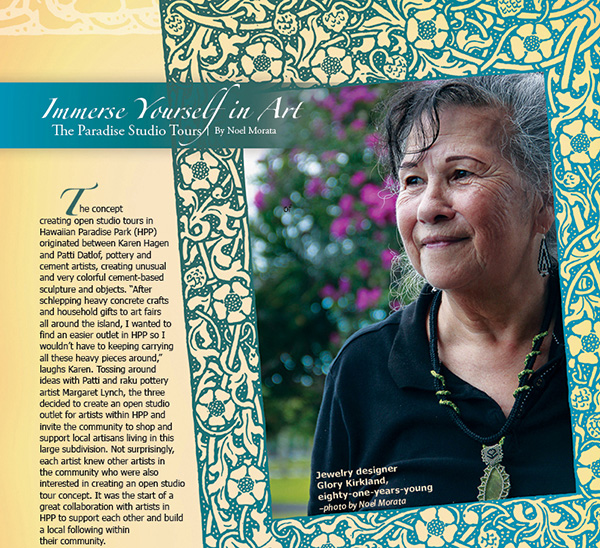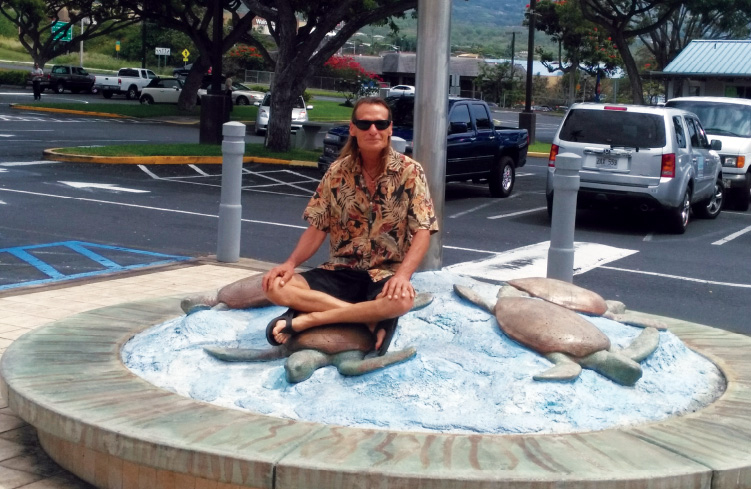
Journey Together: The Art and Poetic Expressions of Terry Taube

By Fannie Narte
“The Thinker,” by Auguste Rodin, perhaps the best-known sculpture of all time, was initially named “The Poet.” This statue has become a symbol of contemplation or thoughtful meditation for millions. “The Thinker,” “The Poet,” contemplation, thoughtful meditation—these ideas offer keys to entering the heart, mind, and soul of artist Terry Taube.
To fully understand the work of an artist, look into the artist’s heart. When you look into his heart, you will see his “life’s poem”—the story of his life. To understand his “life’s poem” is to understand his soul.
Thirteen Year Retreat
Terry experienced a personal renaissance in recent years. He was like an oyster, encased within his shell, foreign matter having entered his soul needing a space to percolate. This was a time of reflection, reassessment, and resetting. When the gestation period ended, Terry emerged a light-filled pearl—an artist with creative clarity and purposeful passion.
Monet found Giverny; Terry found Makalei
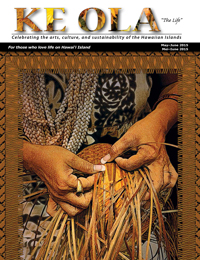
To help me understand his “life’s poem,” Terry takes me on a tour through his garden in Makalei, a subdivision in Kailua-Kona.
“The garden’s been a real part of my life for the last 13 years,” he says. He points to a dying branch on one of the 20 ‘ōhi‘a trees in his garden and expresses his concerns. As we walk over fallen kukui nuts, Terry explains that each kukui nut tree can produce a thousand pounds of nuts, which result in soil that is high in phosphorus.
We meander through the labyrinth of native trees he planted, many of which are endangered species: the ‘a‘ali‘i, wiliwili, olopua, kauila, uhiuhi, hau hele ‘ula, and koai‘e.
With each step we take through his garden, Terry reveals his poetry one line at a time.
He planted trees and discovered the trees planted him
Following in his footsteps, I am careful to walk under and around protruding branches. In the clearing, he points to a green chicken coop, “I have 21 chickens.”
I exclaim, “A lot of eggs!”
Without hesitation, he offers, “I’ll give you a dozen to take home.”
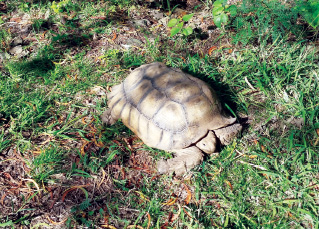
Sprinkled among his native trees are various fruit trees: papaya, lama, and liliko‘i. Hanging above our head is an umbrella of shade; Terry picks and shares some yellow fruit from a loquat tree. Chickens gather at our feet and beg for a taste. With Terry’s permission, I share a handful of loquats with his chickens. They follow us as we walk towards the pomegranate trees where on the ground is an 11-year-old male tortoise named “Moku.”
“Moku has 24 carapaces around the edge of his shell—the amount of hours in a day,” Terry explains. “He’ll live to 150 years and weigh up to 150 pounds. These are the original solar panels, I figure. He’s a total sun bum.”
Our garden tour resumes on the makai (toward the ocean) side of his house through lauhala, sandalwood, and kauila trees.
We walk toward his house past the lānai and head to the deck.
“We didn’t plan it this way, but this deck has three corners and four sides. That’s what the turtle’s about, the three corners in life: honua (earth), pu‘uwai (heart), and lani (heaven). We’re always going around the bend and about the four winds. Everywhere I go, I see turtle,” Terry explains.

Terry’s connection with the turtle began when he was four years old, hanging around some young boys who had found a painted turtle.
“I knew they were going to hurt the turtle, so I took the turtle home. This wasn’t something I wanted to do.
“The next morning my dad and I went fishing on the lake. When we got back to our cabin, the boys came and told my parents that I stole the turtle, and my mom gave them back the turtle.
“Later, I went back to the lake and found the turtle—dead. It was my first heartbreak. The turtle became my universe.”
In the past 30 years, Terry has created over a thousand turtle cast paper sculptures.
Terry sees a parallel between his art and that of French impressionist painter, Claude Monet, and American painter, Georgia O’Keefe. “My work has the reflective quality of Monet, as seen in my sculpture, ‘Monet Ray’ and the boldness and sensualness of Georgia O’Keefe, as seen in my piece titled, ‘Georgia’s Orchid.’”
In addition, Monet and Terry share the same birthday, November 14, one day before Georgia O’Keefe’s birthday, November 15.
From Selling to Telling
Terry’s reentry into the art scene will be at his upcoming exhibit, “Journey Together” on Saturday, May 2 at the BMW of Hawaii Kona Showroom in Kailua-Kona, Hawai‘i.
Journey Together
“My show is about honoring our ancestors. It’s about what the hands, heart, and mind can do when you put them together. The Monet Rays represent the hands, the stone canoe and the turtles represent the heart, and the “He‘e” (octopus) represents the mind. All of these pieces are going to be displayed to tell a story.
“I grew a bunch of gourds that I call the ‘turtle gourd’ because they’re shaped like a turtle. They are probably an old variety of Hawaiian water gourd. These gourds wrote my poem, ‘Twenty-One Turtle Feathers Walking the Worlds.’”

An excerpt from Terry’s poem:
I Thank Turtle for sharing ambient divinity
For sharing Humility
For sharing past and future
For sharing great mystery
I Thank Turtle for being the shape to shift us
For Circling us
For Loving Us
For Helping Us
Terry was born in Detroit, Michigan and lived for a time in California. He moved to Hawai‘i Island 40 years ago from the San Francisco Bay area.
His art career began with the making of gyotaku fish prints. Later, he took a Japanese paper making class from Marilyn Wold where he learned to make flat sheets of paper from pulp using screens. His explorations in papermaking eventually developed into three-dimensional cast paper sculptures.
Terry begins the month-long process of each sculpture by dusting his molds with metal and pearlescent powders. These powders mix and react with the pulp during the casting process, which creates colors found in nature.

He blends two types of pulp, hemp and abaca, into an oatmeal-like consistency. Using a high-tech process, the pulp mixture is sprayed onto each mold in layers, three to four times, allowing it to dry between each application, a procedure that takes approximately two weeks.
After spraying each layer he hand-presses and massages the pulp into the molds. Once the molds are cured, he separates each piece, trims the excess pulp, and cleans up the edges.
“Then it is time to shape, weave, dye, and paint the sculpture. The last step is to coat the artwork with acrylic to preserve and finish its colors.”
In 2005, Terry completed a major public sculpture, “Turtle Eyeland,” located at the Kona Coast Shopping Center in Kailua-Kona, Hawai‘i.
“Each of my pieces are unique. Even though they come out of the same mold, they don’t look the same. They’re all hand worked.
“When people come to my show, I want my exhibit to bring them closer to who they are, to who we all are, to honor ourselves and each other.
“When I read my poem to people, they usually ‘grab onto’ one line. It’s the line they need. It would be good if they can all walk away with one line.”
Terry credits Hawai‘i Island
“I spent a lot of time in the forest and in the ocean. I was able to farm, fish and hunt here for years. I feel so fortunate just to have that direct relationship with nature.”
Heart, Mind, and Soul
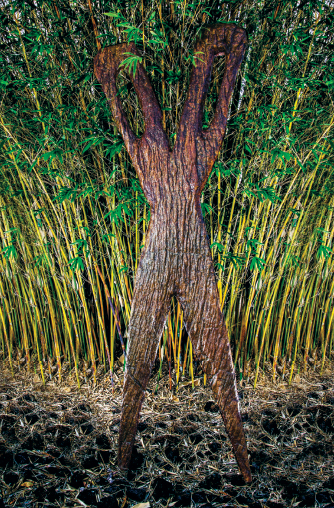
To understand Terry’s connection to nature and his humanity is to understand his soul’s expressions as revealed in his artwork. His work will carry his life’s poem into the timeless future, just as “the turtle spirit will continue to carry the stories and wisdom of the universe, to ‘walk the world.’”
Terry’s renaissance will continue to evolve.
When Terry read his poem to me, I “grabbed onto” the lines:
I Thank Turtle for hatching our hearts
For finding our voice
For helping us sing and dance.
When you discover or rediscover Terry Taube’s artwork and hear his poem, what line will you “grab onto”?
Terry revealed his life’s poem one line at a time during our tour through his garden in Makalei:
“The Thinker”—“The Poet”—“The Artist”—Terry Taube. ❖
Contact artist Terry Taube: 808.325.5496, TerryTaube.com
Contact writer Fannie Narte: info@fannienarte.com

